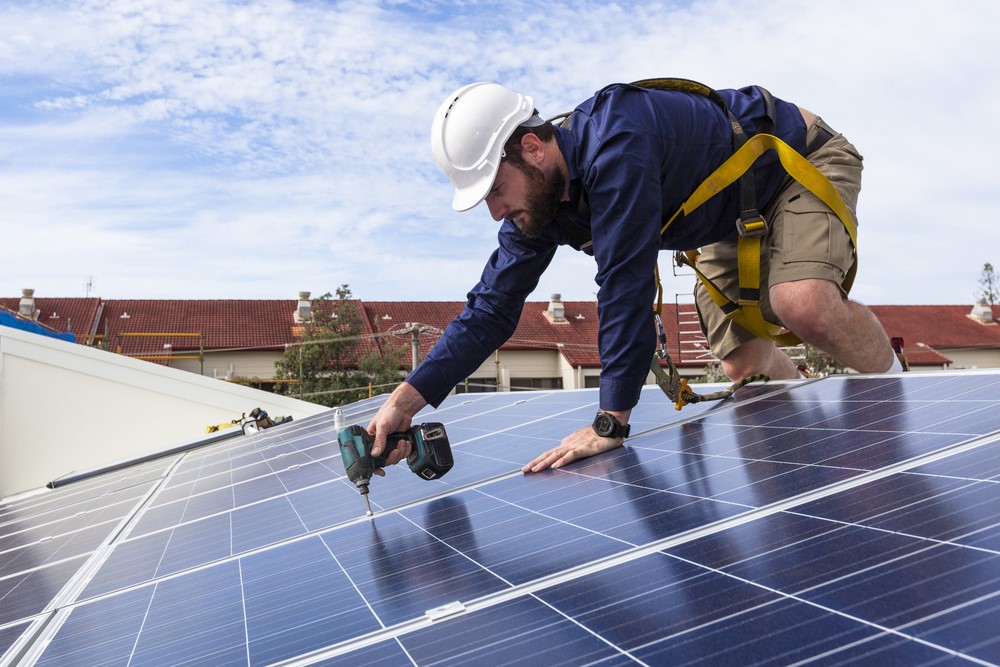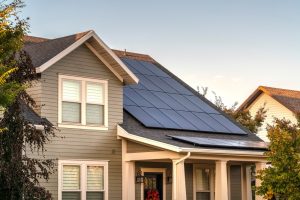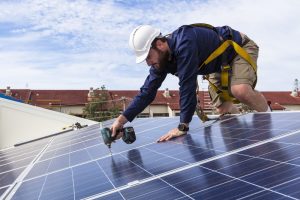Mini-split air conditioning units are some of the most popular types of AC units on the market today. Their efficiency and low power usage make them the perfect type of AC unit to use with solar panels. The first question that typically comes up is, “How many solar panels to power a mini-split?” That answer varies based on the type of mini-split you want to use.
How Using Solar Power With a Mini-Split Works
Over the last few decades, solar power has become a cost-effective way to provide power to a home. Solar panels convert the energy of the sun into electrical energy for your use. They have a flat panel shape and are dark-colored to help capture the sun’s rays. You install them on the roof or in areas of the yard that get a lot of sunlight during the day to get the best results. You can also store the energy generated by the solar panels in batteries until needed.
Source: anatoliy_gleb/Shutterstock.com
Resourceful use of electricity makes mini-split AC units a popular choice for all types of homes, especially those that use solar power. Mini-split units that have earned an Energy Star label use up to 60% less energy than other types of cooling equipment. Using solar panels with Gree mini-splits can cool your home for pennies a day. Using solar energy to power your home is also a good choice because it is more environmentally friendly than other ways to generate energy. Solar panels do not use fossil fuels or emit greenhouse gases to create power.
Mini-split AC units are more compact and energy efficient than traditional HVAC systems. Since they use less power, it is easier to run mini-splits on solar panels and energy stored in batteries. Using solar panels also lets you put mini-splits in rarely used areas of the home, like garages, as well as in RVs and campers. Mini-split units are also easy to install because they do not require ducts. Instead, multiple head units are secured to the interior walls, and a compatible unit ia installed outside. To ensure that they work properly, a professional technician should install the units and test their performance.
Source: Jason Finn/Shutterstock.com
Calculating the Amount of Power Needed by the Mini-Split Unit
To figure out how many solar panels you need to power a mini split, the first thing you should look at is the seasonal energy efficiency ratio (SEER) of the AC unit. If an AC unit has a high SEER rating, it means the unit will need less power to run. A SEER rating of 21 to 23 is good for a mini-split. You can also find high-efficiency units that have SEER ratings up to 35.
Another thing to consider is the amount of voltage needed by the units to operate. AC units with any voltage type can cool your home, but different types of units have different uses. Mini-splits with lower voltage are popular for use in smaller areas, while those with a higher voltage are good for use in larger rooms. For most combinations of solar panels and mini-splits, a high SEER, 115-volt unit is the most likely choice. The number of solar panels needed to power an AC unit depends on the above values and how many units you want to power. Most high-efficiency units available today need 550 to 1,000 watts to operate. So, a unit that needs 990 watts of power needs five 200-watt solar panels and an appropriate inverter to operate.
Benefits of Using Solar Power With Mini-Split AC Units
There are many benefits to pairing your mini-split AC unit with solar panels. The biggest benefit is the decrease in energy costs for cooling your home. When using solar panels, you reduce the amount of electricity drawn from a power company. This lowers your average energy bill by a considerable amount. Solar panels produce the most energy on warm, sunny days, which are also the days when you are most likely to use air conditioning. Abundant sunlight provides the extra power needed to cool your home on those days. Keeping your home cool during the day also reduces the energy needed to make your home comfortable at night.
Another benefit of using solar panels and mini-splits is the ease of expansion if you want to cool a room that is not currently air-conditioned. All you have to do is buy an extra AC unit and add the necessary number of solar panels to power it to your existing system. Using this method, you can also target the areas that need cooling the most instead of trying to cool the entire house all the time. Some mini-split units have moisture removal capabilities. These units can remove excess moisture from around the coils to prevent any humidity-related issues. In some cases, this capability is also known as an auto dry function.
Source: zstock/Shutterestock.com
Conclusion
Mini-split AC units that use solar energy are innovative and cost efficient. Solar panels are built to last and can withstand most types of weather events. Mini-splits running on solar power cool your home with minimal impact on the environment, a big advantage over traditional HVAC units. If you want to learn more about mini-split AC units and how to use them with power drawn from solar panels, contact our expert staff today. We can answer any questions you may have and provide you with great options for cooling your home.




